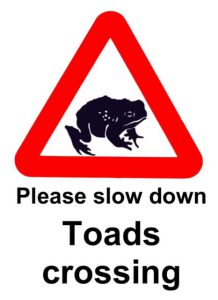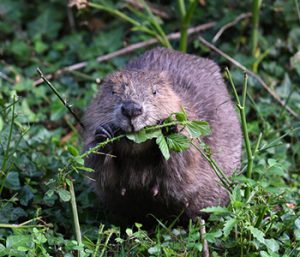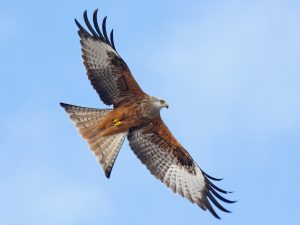In each of these habitats, there is a wonderfully rich diversity of both animals and plants. The wildlife corridors mentioned link up the habitats so ponds become stepping stones and well maintained hedges wildlife corridors. Verges are still a problem in the village, as they ought to be a mass of flowers but excessive mowing and the mulch of cuttings still prevent their return. The much lauded “no mow May” as applied to verges has proved to be a Greenwashing con. All it managed to do was to cut flowers before many had finished flowering let alone setting seed and left a thick smothering mulch boosting the outcompeting grasses. NWG has always endorsed and supported Plantlife and its best practice guide for grassland verges see https://www.plantlife.org.uk/wp-content/uploads/2023/03/Managing-grassland-road-verges_2020.pdf
FAUNA
MAMMALS
Norley has moles, beavers, voles, mice, stoats, weasels, badgers, foxes, polecats, shrews, at least 4 species of bats, hedgehogs, and many, possibly rather less welcome, grey squirrels and brown rats.
Sadly Badgers are still being quite cruelly unnecessarily culled, NWG fully support the CWT’s vaccination programme. Much more can also be done to help Hedgehogs, see HOW CAN I HELP?
Amongst the several species (at least four) of bats there are a lot of Brown Long Eared bats. Their favoured prey are Lesser Yellow Underwing Moths (Noctua comes). Its caterpillars feed on burdock, so NWG has planted a lot around the village in the hope it will boost the population of BLEs. We have also put up a lot of bat boxes to act as summer roosts.
The latest addition has been Beavers, now seven of them in an CWT enclosure in Hatchmere. Absent from Cheshire for over 400 years, these amazing creatures, now officially designated as wild have already transformed their own habitat by building an enormous dam. As they eventually spread through the county, they will help to increase biodiversity significantly. They will also help us cope with higher intensity rainfall by:
- helping to reduce d
ownstream flooding – the channels, dams and wetland habitats that beavers create hold back water and release it more slowly after heavy rain
- increasing water retention
- cleaning water
- reducing siltation, which pollutes water
- making new Wetlands which sequester carbon – essential in this climate crisis
https://www.cheshirewildlifetrust.org.uk/wildlife-explorer/mammals/beaver
BIRDS
In Norley, as in other parts of the UK, there has been a massive decline in birdlife. According to a major new study, an increase in the use of pesticides and fertilisers on farmland has been identified as the main cause for declines in most bird populations across Europe.
The introduction of Wildflower meadows and other conservation techniques in 20 acres of Sandycroft Farm will give pointers to how changes to “modern” agricultural practices are vital to stopping the decline in biodiversity, not only in Norley but nationwide. NWG is already setting up a before and after programme helped by CWAC who are engaged on the project
To some extent this can be mitigated by feeding them in our gardens. (see HOW CAN I HELP?) Goldfinches, siskins and redpolls are now seen regularly, hulled sunflower seeds are the preferred food. But despite money being on offer no landowners have volunteered to grow an annual crop just for wildlife, flowers for pollinators and later seeds for birds in the autumn and winter. The website at https://www.speysidefieldsforwildlife.org/ sets out the principal features and how by providing these annual crops can make an almost magical transformation, At the moment many fields in Norley don’t even have headlands, it’s no wonder so many bird species continue to decline.
Both Tawny and Barn owls enjoy the large vole/mouse population and barn owl boxes have been put up (see USEFUL CONTACTS). Other birds of prey are here too, Kestrels, Peregrine Falcons, Goshawks and recently Red Kites, which in Cheshire many centuries ago were known as Gledes. (From the Old English “to Glide”).
The resilience of wildlife was demonstrated by rooks whose rookery was cut down (not illegal when they are not nesting) and took up their new very cacophonous occupation in the Wildwood around 2017.
INSECTS and other ARTHROPODS
Creepy crawlies or bugs are essentially the linchpin for a healthy ecosystem. Without pollinators such as bees and butterflies many plants would not be able to produce seed (over 80% of plants need pollinating i.e. are entomophilous). Pesticides and habitat loss apart, climate change is a growing threat to a wide range of wildlife, including insects. There is evidence that even slight increases in temperature could cause many bumblebee species to become extinct.
See https://science.sciencemag.org/content/367/6478/685.
NWG has long acknowledged “insectageddon” is a global issue that needs big action to tackle it, but we can improve things by growing plants that pollinators need by providing suitable bee nest sites and food plants for the caterpillars of Moths and Butterflies see HOW CAN I HELP?
Artificial Light at Night (ALAN) has also been raised as a significant reason for the decline in insects, see https://www.sciencedirect.com/science/article/pii/S0006320719307797?via%3Dihub. It affects all aspects of insect life, their movement, foraging, reproduction, and predation, and we need to think urgently as to what can be done to mitigate the worst effects. But first, do we need to have lights on all night? So if you can, PUT THAT LIGHT OUT!
Much has been said about Honey Bees (Apis mellifera) being a possible threat to native bees, both Bumbles and Solitaries, by creating a “halo” of reduced nectar and pollen around apiaries. Whilst it can happen if too many hives are in a location, it should be noted that Honeybees are native to the British Isles, that they are not domesticated and, without beekeepers, honeybees would be effectively extinct from novel pests and diseases introduced by us in the aftermath of globalisation.
In the UK there are effectively no feral honeybee colonies, but these pollinators are vital for both wildlife and ourselves. They are to be cherished, not blamed for any decline in other bee species.
AMPHIBIANS AND REPTILES

The Great Crested Newt (Triturus cristatus) is Britains largest and rarest newt. Here in Cheshire, where they are less rare, they are in still in decline like other amphibians. So Natural England’s programme of conserving existing ponds and making new ones is very welcome. This had been overseen by CWAC and many ponds in Norley have greatly benefitted as a result.
Not forgetting reptiles, the common lizard, slowworms, grass snakes and adders are all found in the Parish. Lizards often sun themselves on beehives presumably dining on any bees they can nab; in turn Pheasants apparently catch the lizards!

 ownstream flooding – the channels, dams and wetland habitats that beavers create hold back water and release it more slowly after heavy rain
ownstream flooding – the channels, dams and wetland habitats that beavers create hold back water and release it more slowly after heavy rain